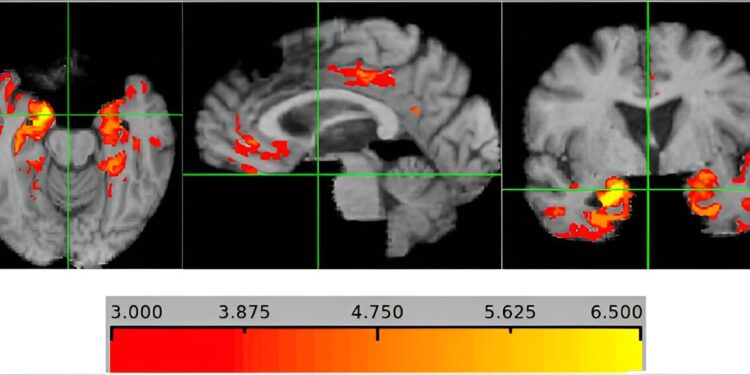Strengths of significant association (regression t-values) for gray matter thickness in Alzheimer’s disease (AD) dementia compared to cognitively healthy controls after accounting for multiple comparisons . Cluster masks significantly associated with AD compared to normal cognition were calculated separately for t-value thresholds ranging from 3 to 6.5, in increments of 0.5. This highlights areas where associations have different but significant strengths. However, gray matter density averages over the t ≥ 3 group were used for analyses. Credit: Alzheimer’s and dementia (2023). DOI: 10.1002/alz.13600
A ribbon of brain tissue called cortical gray matter thins in people who develop dementia, and this appears to be an accurate biomarker of the disease five to 10 years before symptoms appear, said researchers at the Center for Science of Dementia. Health from the University of Texas at San Francisco. Antonio Report (also called UT Health San Antonio).
The researchers, in collaboration with colleagues at the University of California, Davis and Boston University, conducted an MRI brain imaging study published in Alzheimer’s and dementia. They studied 1,000 Massachusetts participants in the Framingham Heart Study and 500 people from a California cohort. The California volunteers included 44% black and Hispanic participants, while the Massachusetts cohort was predominantly non-Hispanic white. Both cohorts were aged on average 70 to 74 years at the time of the MRI studies.
“The great thing about this paper is that if we can replicate it in additional samples, cortical gray matter thickness will be a marker that we can use to identify people at high risk for dementia,” said Dr. lead author of the study, Claudia Satizabal, Ph.D., of the UT Health San Antonio Glenn Biggs Institute for Alzheimer’s and Neurodegenerative Diseases. “By detecting the disease early, we have a better window of time for therapeutic interventions and lifestyle modifications, as well as better monitoring of brain health to reduce individuals’ progression to dementia.”
Replicating the Framingham results in the more diverse California cohort “gives us confidence that our results are robust,” Satizabal said.
Sifting MRIs for a Pattern
While dementias can affect different regions of the brain, Alzheimer’s disease and frontotemporal dementia impact the cortex, and Alzheimer’s disease is the most common type of dementia.
The study compared participants with and without dementia at the time of the MRI. “We went back and looked at brain MRI scans taken 10 years earlier, then mixed them together to see if we could discern a pattern to reliably distinguish those who later developed dementia from those who didn’t. have not developed any,” said co-author Sudha Seshadri, MD, director of the Glenn Biggs Institute at UT Health San Antonio and principal investigator of the Framingham Heart Study.
“This type of study is only possible when you have longitudinal follow-up over many years, as we did in Framingham and as we are building in San Antonio,” Seshadri said. “The people who underwent research MRIs when they were healthy and kept coming back to be studied are the altruistic heroes who make such valuable discoveries and prediction tools possible.”
Results were consistent across populations. Thicker tapes were correlated with better results and thinner tapes with worse results, in general. “Although more studies are needed to validate this biomarker, we are off to a good start,” Satizabal said. “The relationship between weight loss and dementia risk behaved similarly across races and ethnic groups.”
Clinical trial researchers could use the weight-loss biomarker to minimize costs by selecting participants who have not yet developed disease but are on track, Seshadri said. The most they would need to try is experimental drugs, she said.
The biomarker would also be useful for developing and evaluating treatments, Seshadri noted.
Future directions
Satizabal said the team plans to explore risk factors that may be linked to thinning. These include cardiovascular risk factors, diet, genetics and exposure to environmental pollutants, she said.
“We looked at APOE4, which is a major genetic factor linked to dementia, and it was not related to gray matter thickness at all,” Satizabal said. “We think this is a good thing, because if thickness is not genetically determined, then there are modifiable factors such as diet and exercise that can influence it.”
Could the MRI gray matter biomarker be widely used one day?
“A high proportion of people who see a neurologist have an MRI, so this thickness value could be derived by a neuroradiologist,” Seshadri said. “The thickness of a person’s gray matter could be analyzed as a percentile of the thickness of healthy people for that age.”
More information:
Claudia L. Satizabal et al, A novel neuroimaging signature for MDA risk stratification in the community, Alzheimer’s and dementia (2023). DOI: 10.1002/alz.13600
Provided by the University of Texas Health Science Center at San Antonio
Quote: Thinning of the brain region may signal dementia risk 5 to 10 years before symptoms (January 22, 2024) retrieved January 22, 2024 from
This document is subject to copyright. Apart from fair use for private study or research purposes, no part may be reproduced without written permission. The content is provided for information only.



